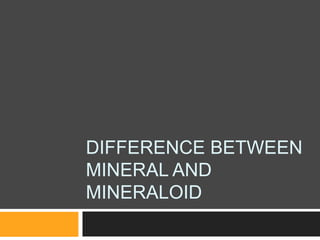Difference between mineral and mineraloid
•Download as PPTX, PDF•
0 likes•447 views
Mineral vs Mineraloid
Report
Share
Report
Share

Recommended
Recommended
More Related Content
What's hot
What's hot (20)
Similar to Difference between mineral and mineraloid
Similar to Difference between mineral and mineraloid (20)
Recently uploaded
This presentation was provided by William Mattingly of the Smithsonian Institution, during the fourth segment of the NISO training series "AI & Prompt Design." Session Four: Structured Data and Assistants, was held on April 25, 2024.Mattingly "AI & Prompt Design: Structured Data, Assistants, & RAG"

Mattingly "AI & Prompt Design: Structured Data, Assistants, & RAG"National Information Standards Organization (NISO)
God is a creative God Gen 1:1. All that He created was “good”, could also be translated “beautiful”. God created man in His own image Gen 1:27. Maths helps us discover the beauty that God has created in His world and, in turn, create beautiful designs to serve and enrich the lives of others.
Explore beautiful and ugly buildings. Mathematics helps us create beautiful d...

Explore beautiful and ugly buildings. Mathematics helps us create beautiful d...christianmathematics
Recently uploaded (20)
Measures of Dispersion and Variability: Range, QD, AD and SD

Measures of Dispersion and Variability: Range, QD, AD and SD
9548086042 for call girls in Indira Nagar with room service

9548086042 for call girls in Indira Nagar with room service
Z Score,T Score, Percential Rank and Box Plot Graph

Z Score,T Score, Percential Rank and Box Plot Graph
Mattingly "AI & Prompt Design: Structured Data, Assistants, & RAG"

Mattingly "AI & Prompt Design: Structured Data, Assistants, & RAG"
Explore beautiful and ugly buildings. Mathematics helps us create beautiful d...

Explore beautiful and ugly buildings. Mathematics helps us create beautiful d...
A Critique of the Proposed National Education Policy Reform

A Critique of the Proposed National Education Policy Reform
Beyond the EU: DORA and NIS 2 Directive's Global Impact

Beyond the EU: DORA and NIS 2 Directive's Global Impact
Call Girls in Dwarka Mor Delhi Contact Us 9654467111

Call Girls in Dwarka Mor Delhi Contact Us 9654467111
IGNOU MSCCFT and PGDCFT Exam Question Pattern: MCFT003 Counselling and Family...

IGNOU MSCCFT and PGDCFT Exam Question Pattern: MCFT003 Counselling and Family...
Disha NEET Physics Guide for classes 11 and 12.pdf

Disha NEET Physics Guide for classes 11 and 12.pdf
Difference between mineral and mineraloid
- 2. Mineral is a naturally occurring, solid, inorganic substance with definite crystal structure and must have a definite chemical composition. What is Mineral? Figure: Mineral (Pyrite and Quartz)
- 3. Mineral must have Five properties : Naturally Occurring - Minerals are found on Earth and not man-made, Inorganic - Minerals must not consist of living materials, Solid - Minerals must have a definite shape and volume, Crystal Structure - Particles inside minerals form a crystal pattern, Definite Chemical Composition - Minerals are made up of elements from periodic table. What is Mineral?
- 4. A mineraloid is a mineral-like substance that does not demonstrate crystallinity. Mineraloids possess chemical compositions that vary beyond the generally accepted ranges for specific minerals. For example, Obsidian is an amorphous glass but not a crystal. What is Mineraloid?
- 5. A material must meet the following five requirements - naturally occurring, inorganic, solid, ordered atomic structure, definite chemical composition (can vary within a limited range) whereas A mineraloid is a naturally occurring, inorganic solid that does not exhibit crystallinity. Moreover, mineral become mineraloid when any of the five properties got missed. Mineral vs Mineraloid
- 6. Mineraloid may have the outward appearance of a mineral, but it does not have the “ordered atomic structure” required to meet the definition of a mineral. Some mineraloids lack the “definite chemical composition” required to be a mineral. Minerals are “crystalline.” In other words, they have an ordered atomic structure whereas mineraloids are “amorphous.” This means that their internal atomic structure is not ordered. Mineral vs Mineraloid
- 7. For example, Olivine, Pyroxene, Muscovite, Biotite, Calcite and others are the examples of minerals whereas Obsidian is a mineraloid which is a volcanic glass and Pumice, Opal etc. are the mineraloid as well. Mineraloids can be liquid; Water and mercury are often classified as mineraloids whereas mineral must be a solid. Mineral vs Mineraloid
- 8. Images of Mineraloid Figure: Water Figure: Obsidian Figure: Opal
- 10. https://geology.com/minerals/mineraloids/ https://socratic.org/questions/what-are-5-properties- of-minerals http://www.geologyin.com/2017/11/what-is- difference-between-mineral-and.html References